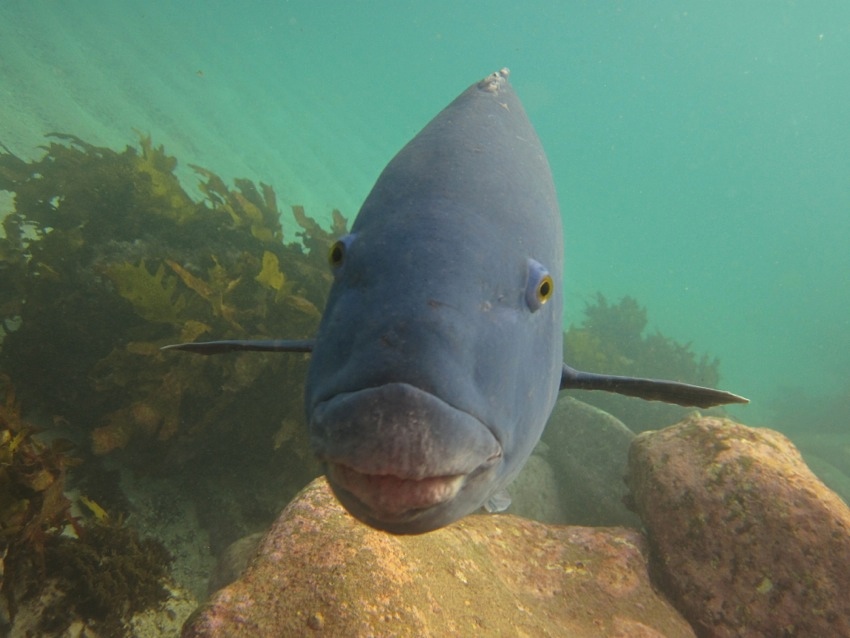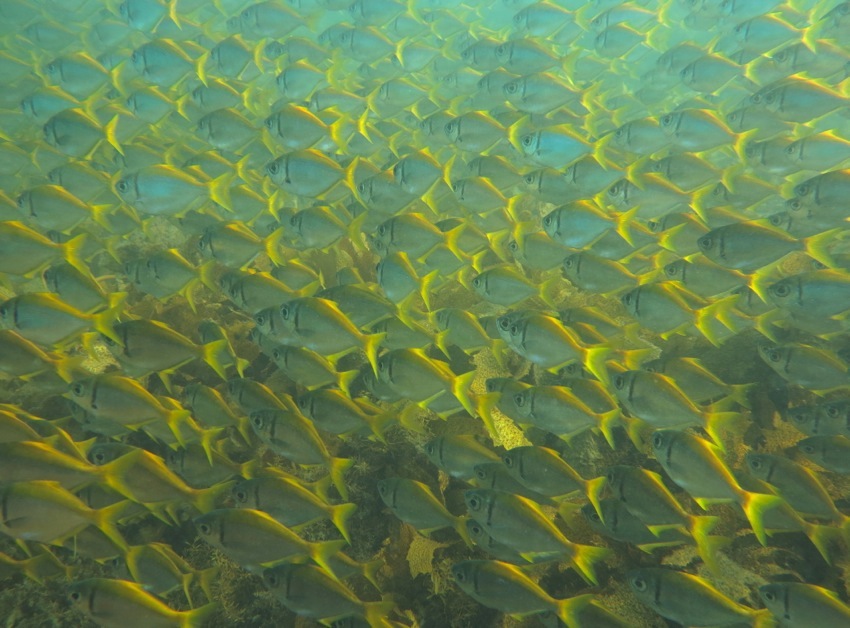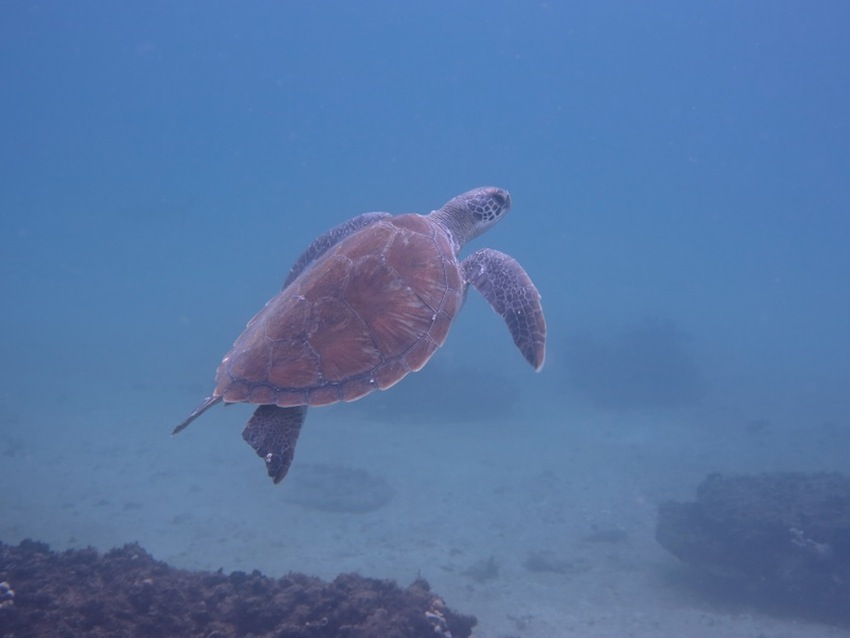When writing these posts I’ve not generally tried to give them a specific sense of place – their place is the sea, the whole sea. But most of the photos seen on this site were taken in a couple of marine parks and reserves in New South Wales (NSW), Australia, and a great many of them were taken in one small reserve on the edge of Sydney, in Manly, called Cabbage Tree Bay. I remember a little of what that place was like before it was made into an aquatic reserve. It was an attractive bit of coast with nothing special in the water. A few spearfishers wandered up and down, and the water was pretty empty.
A bit over ten years ago, it was made into a reserve with no fishing or collecting of any kind allowed. Before long it became a magical place. This is where most of the Giant Cuttlefish featured on this site live, and it’s teeming with fish of all sizes and colors. Eccentric companionship is provided by the huge Blue Gropers who wander along the reefs that the spearfishers used to clean out. These fish are inquisitive and friendly. If you don’t have scuba tanks on (hence no bubbles) they come peering in close to your face, and do ungainly dances through your legs. If you’re under a ledge watching a Giant Cuttlefish, they often come in to see what’s going on.
Given all this, it was dismaying to come back to the site today and learn that the NSW State Government has temporarily lifted the ban on fishing from the shore in almost all marine sanctuaries in the state. No one is fishing at Cabbage Tree Bay yet, and some of the literature I’ve seen suggests this particular site is still off-limits for now. But this change in policy is a huge step backwards for the state. Only a tiny fraction of the coast had been made off-limits to all fishing, and these areas have become different in the water from anywhere else.
Why has this happened? Why would the state government want to do such a thing? Part of it involves the intricacies of NSW state politics. Because of the voting system, one of the two chambers of the state government (the ‘upper’ house) often contains a few representatives from very small parties focused on one issue. The party in charge in the main ‘lower’ house may need support from one or more of these smaller parties to get things done. In the present parliament the ‘Liberal’ party runs the lower house, but does not quite have a majority in the other, and in that house are two representatives of the ‘Shooters and Fishers Party.’ You can guess their agenda from the name (and to be fair, in the US they would probably be called the ‘Patriotic Wildlife Protection Party’ – some credit is due for honesty). The state government has made a series of awful compromises with the Shooters and Fishers. What is important now, while the final decisions about marine parks are still being worked out, is to make it clear that if our few tiny sanctuary areas are cleared out by fishermen, Barry O’Farrell’s state goverment will be remembered as a destructive body that wrecked some rare and beautiful places that are valuable to the state in a host of ways. It also needs to be clear that this policy will have costs for the Liberal party in the present.
This blog now has readers from many countries round the world. If you think protecting sanctuary areas is important, it would be great if some of you could write to the state government here, and tell them what you think. I doubt that they’re expecting international attention on this, and it might make quite a difference. If you’re an Australian reader, please write too. Premier Barry O’Farrell’s website and contact information are here, and the Environment Minister, Robyn Parker, has her website here.
__________
Notes: “Blue Gropers” are not really Gropers, but Wrasses (Achoerodus viridis). I’ve never met a friendlier fish. A famous individual named “Bluey” was speared in 2002 at another beach, Clovelly. The NSW premier at that time, and later the Australian Foreign Minister, was Bob Carr. He called the unknown killer “a mongrel,” and said of the fish: “I have swum with him… he was a friend of mine.” This incident may have had some role in the creation of Cabbage Tree Bay aquatic reserve, which certainly has many Blue Gropers. This species remains legally protected, but there is no way a line cast from shore can discriminate this fish from others.
Updates: the Australian Marine Conservation Society has a petition site about the sanctuaries here.
Letters to the NSW Premier are being redirected, it seems, to the Minister for Primary Industry, Katrina Hodgkinson. (Her email: office@hodgkinson.minister.nsw.gov.au.) It doesn’t seem ideal to have the Department of Primary Industry in charge of decisions about marine sanctuaries.




In a very real sense, what is at stake here is indeed “the sea, the whole sea” and not just one specific place. If Peter had not been able to dive in these sanctuaries, he would not have been able to purvey his observations and ideas to followers like me and my four-year-old son here in Sweden. My son would not have had his enthusiasm for cuttlefish and other organisms nourished as it has been nourished by the vividness of this blog. Such changes in small relationships with specific places ramify into larger relationships with nature. If places like Cabbage Tree Bay are opened up to fishing, the next generation of NSW citizens will have more opportunity to become Fishers or Shooters there, who might otherwise have learned to conserve, curate, and further our understanding of those marvelous creatures of the deep.
Thanks for keeping the world up to date on such issues. I’ve just visited some sites in Australia with Peter over the last few months, and Australia has some amazing marine life worth world-wide attention and protection. I am a long-time believer in no-take protection, and stories like Peter’s about its effects can be found everywhere no-take reserves have been established. Scientifically, there remains controversy about whether the effects of no-take reserves are as large as some have claimed, but they clearly are an important part of the mix in marine conservation. Given how few there are anywhere in the world, the concern over losing protection is justified.
I wrote to both Premier O’Farrel and the EM to stress the value of no-take marine reserves in Australia and world wide. The Marine Conservation Institute has just launched (Oct 2013) the Global Ocean Refuge System, to address a shortage of no take marine reserves world wide. I hope Australia will play an international and visionary role in promoting ocean conservation, in part by restoring previous no-take protection that has recently been lifted.
Written to both:
I’m writing to express my great concern at news that restrictions on fishing in NSW coastal waters have been lifted. Lifting all restrictions across the board is a profoundly reckless way to treat these delicate ecosystems, which have been thriving thanks to the protection they’ve seen over the past decade or so. In addition, the presence of fishing lines and hooks in the water makes coastal areas less safe for swimmers and divers.
Concessions can be made to recreational fishers without such an extreme change to the present policy. Jervis Bay in NSW has had it right: http://www.mpa.nsw.gov.au/jbmp-overview-6.html
and http://www.mpa.nsw.gov.au/jbmp-map-01.html.
There is a large sanctuary zone that is protected by total fishing bans, and a large habitat protection zone where line fishing is permitted, and it’s reasonable to assume that the sanctuary zones in fact maintain a nice supply of fish for the fishers in the habitat protection zone.
This is the kind of zoning balance that should be mimicked in other areas.
Sent to both. Thanks for your ongoing gentle agitation for our amazing marine creatures.
I’m writing to express my fear that the NSW government is going to allow fishing in marine sanctuaries. The vast majority of coastal areas are already available for recreational fishing and the few protected sanctuaries play an important and proven regenerative role in our marine systems.
Please don’t sell our marine heritage for short term political advantage. I know that the Liberal party can govern with vision and leadership . Please stand firm and protect our Blueys.
http://giantcuttlefish.com/?p=3982
Thanks Ros. I agree that there is no reason in principle why the Liberal party should be going down this road. Apart from anything else, it makes no economic sense, given the impact it will have on tourism and the dive industry. And in places like Cabbage Tree Bay, who would want to see 10 year old kids learning to snorkel in water full of old fishing lines and fish hooks (as Jane notes in her comment)?
Posted to Facebook.
emails to both contacts as follows:
Wildlife sanctuaries are an important tool in the protection of animal and plant diversity. I’d ask that NSW retain protection of the few marine reserves. This article says it all: http://giantcuttlefish.com/?p=3982
Thank you for your consideration.
It’s not much but I hope it helps. Your photos and articles are always amazing. I live in the US but had the opportunity to swim in the waters around Okinawa back in the late 60’s. The water was as clear as glass and the fish were not to be believed. I really appreciate your effort to protect similar habitats. Best of luck!
Thanks Doug. I do think this sort of contact makes a difference.
Okinawa waters in the 60s – amazing thought.